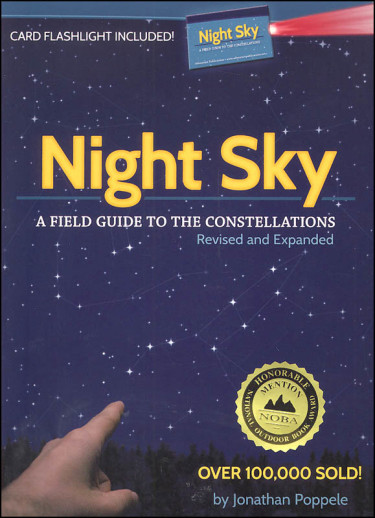We use cookies to make your experience better. To comply with the new e-Privacy directive, we need to ask for your consent to set the cookies. Learn more.
Night Sky - Field Guide to the Constellations
Don't get me wrong I like stars, but I'm more of a life science girl. While I enjoy stargazing (especially on nights with a chance of shooting stars), I see books written for amateur astronomers and in between the terminology, the multiple charts, the equipment recommendations it just seems so complicated! When I picked up this guide and realized it was something even I could use with ease, I thought other astronomy-phobes might appreciate it too. This little guide is several things in one: a field guide to constellations, a stargazing challenge-in-a-book, and a source for constellation-related mythology. Plus, it's got a handy little credit card-sized red LED flashlight in the back, so you can read it while stargazing great idea! The bulk of the book contains constellation field guide entries for the four seasons of the year, viewed within the continental U.S. Within each season, constellations are arranged in order by how easy they are to locate, and readers are encouraged to start with the easy ones and work towards the more difficult-to-find. Every constellation is given several pages a full-color illustration of the constellation with major stars noted, the name, size, when to look for it, notes, details on the major stars, and related mythology or astronomical history related to the constellation. There are two methods given for locating the constellation; an overhead map and a horizon map. The overhead map tells you to face south, hold the book overhead, and use the red dot (the point directly overhead), the Big Dipper and the North Star to find the constellation (depicted with a yellow star). The horizon map is organized by the time of year, and tells you which direction to face and how high on the horizon to look. Ingenious! I think I just found a terrific stargazing "buddy." Additional information on stargazing and the solar system is also included; although from a secular publisher, the emphasis is on stargazing, not on the origins of the universe. Revised and expanded in 2018. 384 pgs, pb. ~ Jess
This award-winning book takes a simple approach to finding 64 constellations by focusing on one constellation at a time, teaching how to locate any constellation in relation to the Big Dipper, the North Star, and the top of the sky while also introducing mythology, facts, and tidbits.
| Product Format: | Softcover Book |
|---|---|
| Brand: | Adventure Publications |
| Author: | Jonathan Poppele |
| Grades: | 4-AD |
| ISBN: | 9781591932291 |
| Length in Inches: | 6 |
| Width in Inches: | 4.375 |
| Height in Inches: | 0.75 |
| Weight in Pounds: | 0.8 |

